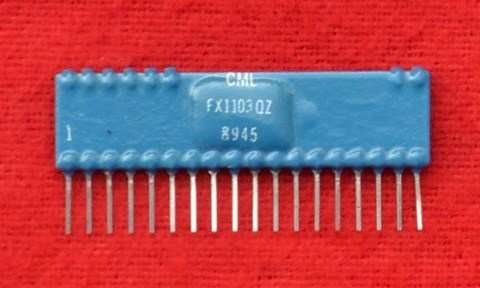FX1103 Hybrid Selcall
Features
- Low Power Consumption
- Single-In-Line Hybrid Construction
- FX1103C Decodes CCIR Toneset
- FX1103Z Decodes ZVEI Toneset
- Group Call Decoding
- Dual Address Feature
- Coded Audio Alert Output
- Absent Page Memory
Description
The FX1103 is a 5-tone selcall decoder packaged in a S.I.L. thick film hybrid encapsulation. The FX1103 includes an FX003 tone decoder tuned to either CCIR or ZVEI tones and an FX103 address decoder. The FX1103 can operate from a three cell battery and consumes a minimum of power.
Operation
The hybrid decodes sequential 5-tone selective calling signals, and compares the incoming information with an address stored in a memory. The FX1103 automatically generates an interrupted audio alert signal when it decodes its correct address sequence. A continuous audio alert is generated when the decoder receives its address followed by an additional instruction tone (tone C). This provides a two address pager from only one address code.
Group Call
The hybrid will decode group calls where any one or more digits of the address have been replaced by a group frequency (tone A). Groups ranging from ten units to all the pagers on a network can be simultaneously called. The hybrid will output a distinctive audio alert pattern when a group call is decoded. The additional second address instruction tone is also valid for group calls and causes the circuit to generate a continuous alert.
Audio Alert Memory
The audio 'Alert' output can be manually reset by the 'Alert Reset' input. If the audio is not reset within 10 seconds the hybrid will clear the 'Alert' output. The audio pattern type is then loaded into a memory. Pressing the audio reset button will cause the memory contents to be reloaded into the alert pattern generator.
This "absent page memory" feature stores the last audio alert output which self-timed out. The audio pattern Output can be reset in the normal manner.
Mute Output
The FX1103 includes a 'Mute' output which is switched high when the device decodes an incoming selective call. This can be used to enable the audio amplifier of pagers equipped for "tone + voice" operation. It remains on until reset by the 'Mute Reset' input. The 'Mute' output can be considered as a call signal in "tone only" applications.
In this case the 'Mute Reset' and 'Alert Reset' inputs can be connected together.
Power On Reset
Power on reset components are included in the hybrid. This prevents malfunction when power is applied. A 5 second burst of rapid pips is generated at the 'Alert' output as a power on test. The maximum power supply rise time (to 90%) for correct Operation is 2ms.
Transmitted Instruction Codes
The FX1103 can decode selectively addressed reset instructions, using extra tones decoded in addition to those specified by CCIR and ZVEI. Address suffix tones can be added after a selcall to reset the 'Mute' output and also erase the memory. The Mute is reset when tone D follows a call. Only when this is followed by tone C will the device erase the memory, any other state (or no transmission) will inhibit the erasure. These transmitted instructions are also valid under group calling conditions.
A voice paging system organised with transmitted reset instructions offers the possibility of hands-free operation at the receiver.
External Components
The FX1103 requires a 560kHz clock which can be derived from a ceramic resonator, and tuned to the precise frequency by a variable (or select-on-test) capacitor. Pin wiring should be kept short. The frequency is monitored at pin 14 by a high impedance counter with low capacitive loading. This single adjustment tunes all the receiver frequencies.
External Address Memory
The selective calling address must be stored in a separate external memory. The memory input and output lines of the FX1103 have been designed to interface directly to fusible link diode matrices. Selcall numbers are programmed into the matrices directly and without repeat codes (code E). The circuit automatically recognises where successive address digits are identical and searches for the repeat tone. The code E is used in the memory where less than five address digits are used. It is programmed into the external memory after the last digit and instructs the FX1103 to search for address suffix tone codes or the no transmission state.
The Q1-Q5 outputs are taken to the cathodes of the diode matrix and the anodes are connected to the D10 - D13 inputs.
Handling
The FX1103 contains CMOS LSI integrated Circuits which include input protection circuitry. However, precautions should be taken to prevent static discharges which can damage the circuitry.
